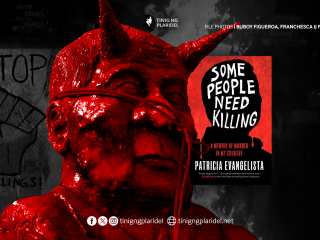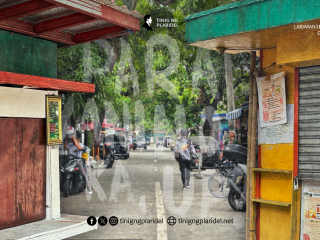By Teresa Barre and Meeko Angela Camba
Flags of protest flew high over more than a thousand members of the national minorities and students as they marched to Mendiola Friday afternoon to cap off the two-week protest caravan, Kampuhan 2016 hosted by the University of the Philippines Diliman.
At the front lines were minority leaders, clad in their traditional garb, united under one call: a just and lasting peace and the right to self-determination.
“Walang pagkakaiba [ang hinaharap ng] 108 na ethno-linguistic groups [dito sa bansa]. Iisa [lang] yung adhikain at ito ang pagkilala sa sariling pagpapasya ng mga katutubong mamamayan,” Cordillera People’s Alliance leader Ampi Manili said.
Hailing from the Mountain Province, the Ibaloi leader also said Lakbayan 2016 served as a platform for national minorities from all over the country to share their experiences and act together.
“Yung mga Moro na noon ay hiwalay, sumasama na sila [ngayon] sa panawagang pagpapasya ng [mga] katutubong mamamayan,” he said.
Meanwhile, Sonny Serrano, leader of the Central Luzon Aetas’ Association, shared how their former negative view of Moros was changed after being able to interact with their fellow minorities during the Lakbayan period.
“May mga sinasabing ‘yung mga Moro, terorista ‘yan. Pero hindi pala kasi katulad din namin silang lumalaban,” Serrano said.
A united front
Unlike in the previous years, Lakbayan 2016 (previously called “Manilakbayan”) welcomed over 3000 participants from various cultural groups–a huge leap from last year’s 700 Lumad contingents from Mindanao.
For about a week, participants took part in cultural performances, educational discussions and protests, which will continue until Oct. 28. All activities call on the government to end the “creeping militarization and plunder of ancestral lands and territories” by mostly foreign-owned corporations.
“Nais namin na palayasin ang mga dayuhan, lalong-lalo na yung kumokontrol sa ating ekonomiya at usapin ng seguridad na matagal nang nakapinsala, nakapagpahirap at nagpalala ng diskriminasyon sa aming mga katutubo at mamamayang Moro,” Malayao said.
According to Manili, one particular success of this year’s caravan was the establishment of Sandugo: Kilusan ng Moro at Katutubong Mamamayan para sa Sariling Pagpapasya (SANDUGO), an alliance which seeks to forward the rights of the national minorities who comprise about 15 percent of the total Philippine population.
SANDUGO, created Oct.19, is composed of different organizations such as the Kalipunan ng Katutubong Mamamayan ng Pilipinas, Suara Bangsamoro, the Cordillera Peoples’ Alliance and the Kusog sa Katawhang Lumad.
One of its first resolutions is the call for a separate clause for national minorities in the Comprehensive Agreement on Socio-economic Reforms (CASER), a document first drafted in 1998 which seeks to resolve historical and structural inequities in Philippine society.
The Philippine government and the National Democratic Front of the Philippines (NDFP) representatives have already agreed on the CASER’s outline and framework, Oct. 9.
Meanwhile, NDFP consultant Loida Magpatoc assured the Alliance that concerns such as agrarian reform, rural development and the rights of working people are already included in the CASER’s draft.
Though there were victories in the Lakbayanis’ journey to the nation’s capital, the voyage also bore witness to an injustice perpetrated by state elements similar to the one they face back in their communities.
Violent dispersal
Around 50 protesters suffered various injuries when members of the Philippine National Police (PNP) dispersed a peaceful rally held by national minority groups and their supporters in front of the United States Embassy, Oct. 19.
One of those injured by a police vehicle that ran over protesters is Piya Macliing Malayao, the lead convenor of SANDUGO and the granddaughter of Macliing Dulag, a Cordilleran leader assassinated for his opposition of the Chico Dam Project in the 1970s.
Malayao condemned the violent dispersal, seeing it is as an attack to Filipinos who are fighting for an independent foreign policy for the country. The protest came a day before President Rodrigo Duterte announced in Beijing the Philippines’ separation from the U.S. in terms of military and economic policy.
“Pinakamataas po ang aming pagkundena doon sa marahas na pag-disperse at aktibong pag-atake sa aming mga pambansang minorya doon sa U.S. Embassy,” said the crutch-bound Malayao to the crowd gathered in front of the Mendiola Peace Arch.
“Malinaw po na ito ay pagpapatupad ng isang security policy ng Estados Unidos laban sa mga mamamayang Pilipino lalo na [laban] sa mga nakikibaka para sa isang foreign-independent na polisiya ng ating bansa,” she added.
Furthermore, Malayao said she and other victims plan to file legal charges against the policemen responsible for the violent dispersal.
“Liban sa pagsuspinde, pagpapatalsik sa mga pulis na ‘yan–pangunahin yung may mga command. Gusto naming na sila’y managot at makulong,” she said.
Meanwhile, Manili expressed his frustration on how violence seem to persist beyond their communities.
“It’s very very disgusting, bayolente. In fact nararanasan naman talaga yung brutal ng military sa kanayunan…Tapos dito sa Manila ganyan pala,” he said.
Despite this, Manili said SANDUGO plans to continue their struggle in forwarding the issue of self-determination among the minorities, aiming to coordinate at least annually to maintain a united front.
A great disparity
The Lakbayanis also shared their learnings from their one-week stay at the country’s economic and political center.
Nico de los Santos, a Dumagat youth leader, laments the waste of natural resources in the metro, citing the water fountains he saw at shoppings malls. He was only a little over 3-years-old when his father was killed by military forces for opposing the construction of the Laiban dam in Tanay, Rizal in 2001.
“Bakit dito ang daming nasasayang na tubig kung saan pinagkakakitaan nila o hinahagisan ng pera?” he said. “Pagpupunta run, hahagisan nila ng pera—minsan limang piso, o sampung piso! Kahit nga piso, panghihinayangan ko pang ihulog dun.”
Similarly, Manili told of his people’s surprise upon seeing how seemingly developed Metro Manila is compared to their communities in the Cordillera region despite providing the resources for the capital to thrive.
“Siyempre yung mga katutubo may culture shock. Kasi [may] ganito: magagandang kalsada, magagandang building. Punta ka naman sa bayan, sa kanayunan walang ganoon,” he said.
“Ang yaman ng bansa ay nanggagaling sa teritoryo (ng katutubo)…Eh bakit ang teritoryo namin walang ospital, walang kalsada?” Manili added.
While some of the minority groups from Northern and Central Luzon have gone home, the second half of the Lakbayan commences at the UP CMO grounds with the Mindanao contingent.
Though there is still much road to be covered in the minorities’ journey towards self-determination, Lakbayan 2016 proved monumental in unifying diverse groups of people under one cause.
From this day forth, the caravan is no longer an isolated battle for one repressed ethnolinguistic group alone, but a goal which many now share. #








